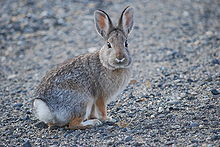- Mountain cottontail
-
Mountain Cottontail 
Conservation status Scientific classification Kingdom: Animalia Phylum: Chordata Class: Mammalia Order: Lagomorpha Family: Leporidae Genus: Sylvilagus Species: S. nuttallii Binomial name Sylvilagus nuttallii
(Bachman, 1837)
Mountain Cottontail range The Mountain Cottontail or Nuttall's Cottontail (Sylvilagus nuttallii) is a species of mammal in the Leporidae family. It is found in Canada and the United States.
Contents
Description
Mountain (Nuttall's) Cottontail is a small rabbit but its size is relatively large for the genus. Hind legs are long; the feet are densely covered with long hair. Ears are rounded at the tips and relatively short; the inner surfaces are noticeably haired.[2]It has pale brown fur on the back, a distinct pale brown nape on the back of the head, black-tipped ears, a white gray tail, and a white underside. A smaller size, the brown nape on the back of the head distinguish this cottontail from the Snowshoe Hare.
Range
This species is confined to the inter mountain area of North America. It ranges from just above the Canadian border south to Arizona and New Mexico, and from the foothills of the eastern slopes of the Rocky Mountains and west to the eastern slopes of the Cascade-Sierra Nevada Range.[2]
Diet
Mountain Cottontail diet is made up in large part of grasses such as wheatgrasses, needle-and-thread, Indian ricegrass, cheatgrass brome, bluegrasses, and bottlebrush squirreltail.[3] Dependent on the area the diet may include quantities of shrubs such as Big sagebrush, rabbitbrush, and saltbushes. As food source becomes more limited in the winter months the diet may turn to more woody plants such as bark, and twigs.
Reproduction
The nest of S. nuttallii is reported to be a cup-like cavity lined with fur and dried grass. The top of the nest is coved with fur, grass, and small sticks, probably placed there by the female. The average fetal sex ratio in Oregon was 1 male to 1.05 females; the adult sex ratio was 1 male to 1.18 females.[2] Depending on location, the breeding season will vary but ranges through February to July, and possibly later in warmer climates. Mean litter sizes average 4–6 kits per litter.[2] The gestation period for this cottontail is 28–30 days, and the female may be bred during postpartum estrous.
Behavior
Most activity for these rabbits is before 0900 and after 1600 hours. They are not a social species and spend the largest quantity of time performing non social behavior. The most common social behavior seen is during reproductive actions or courting. Over 50% of the time the Mountain cottontail is active it is feeding.[4]
References
- ^ Smith, A.T. & Boyer, A.F. (2008). "Sylvilagus nuttallii". IUCN Red List of Threatened Species. Version 2009.2. International Union for Conservation of Nature. http://www.iucnredlist.org/apps/redlist/details/41300. Retrieved 01 February 2010.
- ^ a b c d Chapman, Joseph A., 1975, Sylvilagus nuttallii, Mammalian Species No. 56, The American Society of Mammalogists
- ^ Johnson, Mark K., Richard M. Hansen, Feb 1979, Foods of Cottontails and Woodrats in South-Central Idaho, Journal of Mammalogy, Vol. 60, No. 1, pp. 213-215
- ^ Verts, B.J. and Steven D. Gehman, Activity and Behavior of Free-Living Sylvilagus nuttallii, Department of Fisheries and Wildlife. Nash Hall, Oregon State University Covalis, Oregon 97331
Categories:- IUCN Red List least concern species
- Sylvilagus
Wikimedia Foundation. 2010.

